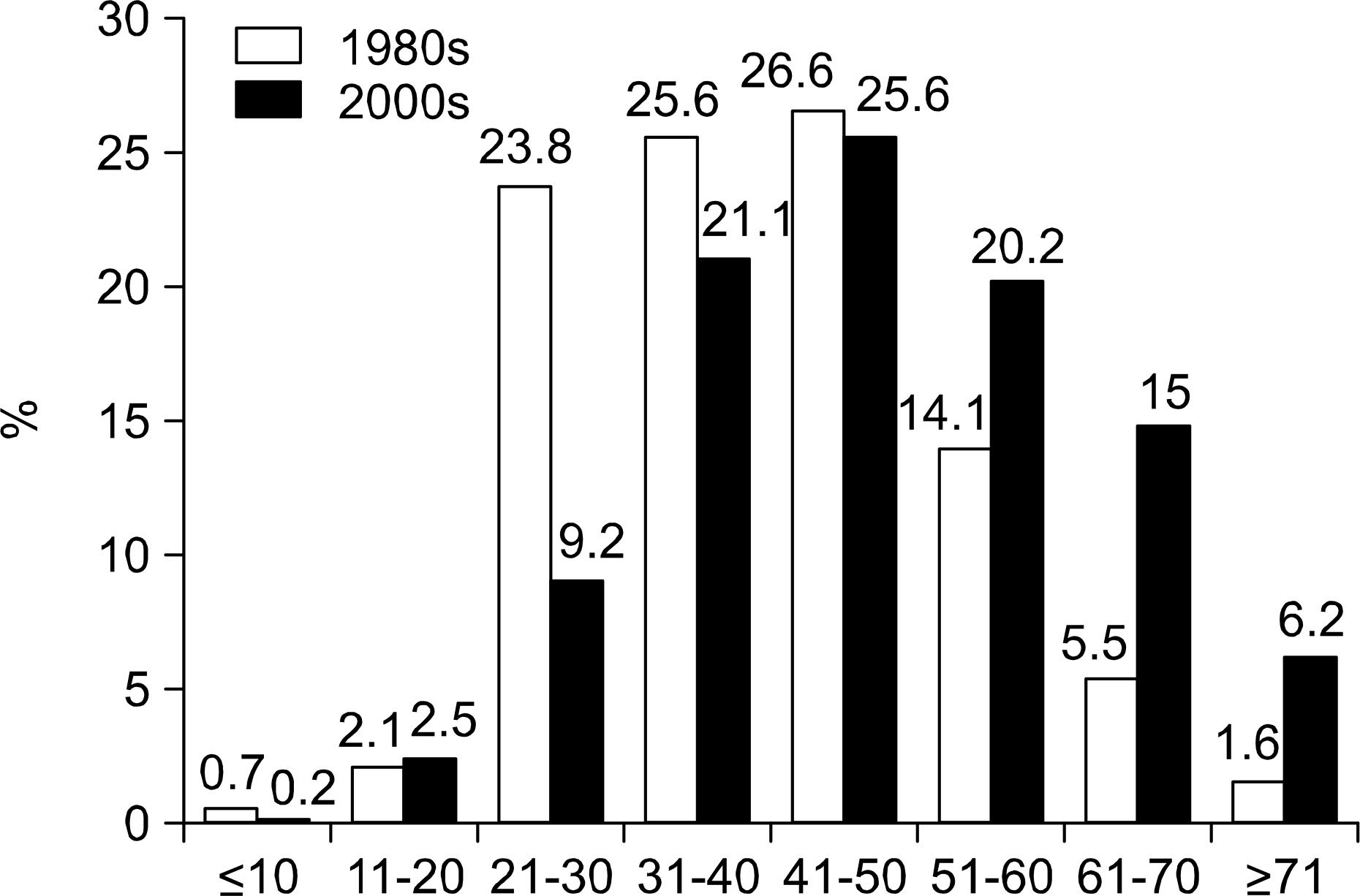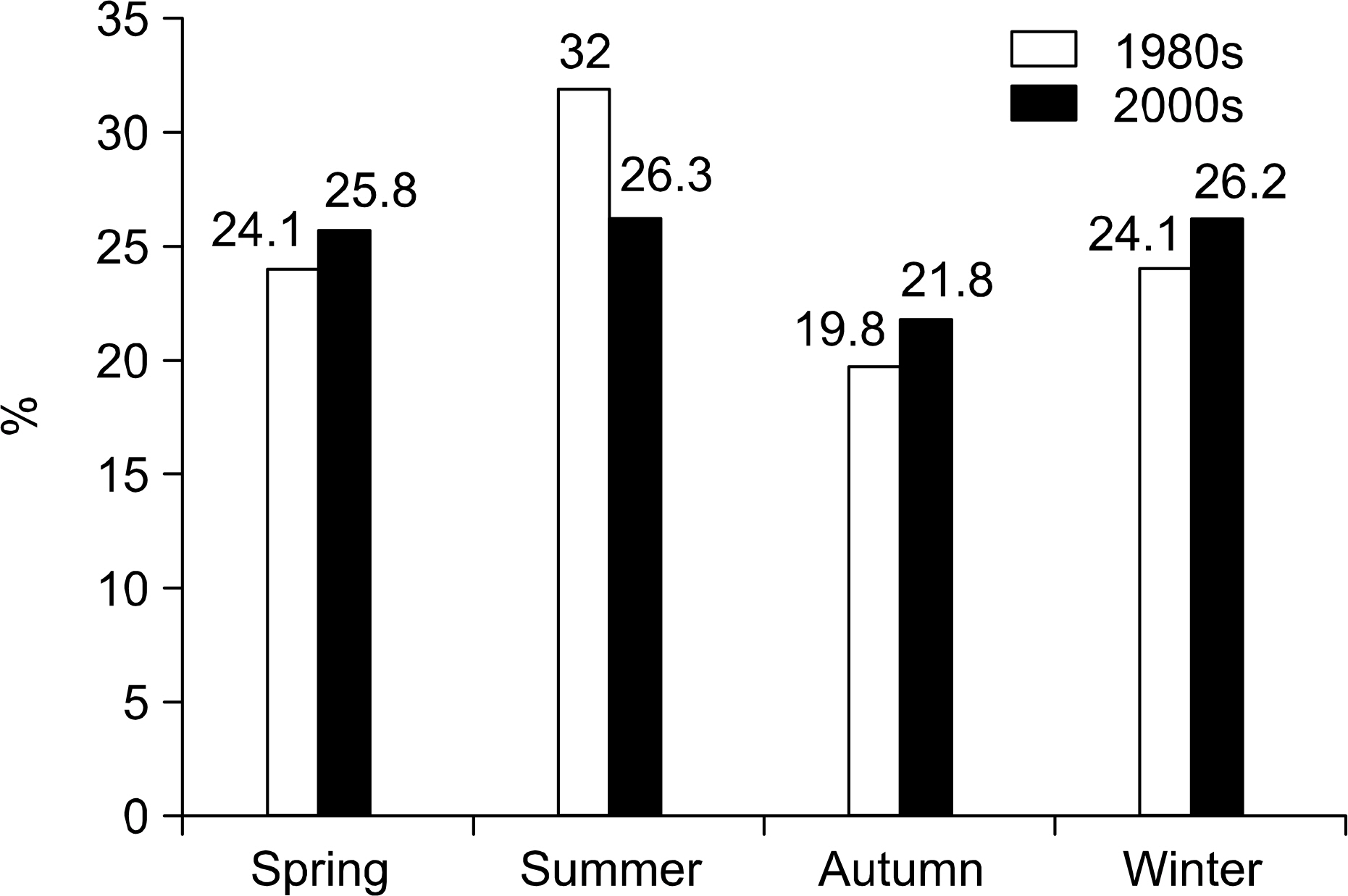Korean J Urol.
2007 Jan;48(1):40-44. 10.4111/kju.2007.48.1.40.
The Trend Change of Incidence and Treatment of Urolithiasis between the 1980s and 2000s
- Affiliations
-
- 1Department of Urology, College of Medicine, Ewha Womans University, Seoul, Korea. bonstone@ewha.ac.kr
- KMID: 1915019
- DOI: http://doi.org/10.4111/kju.2007.48.1.40
Abstract
-
PURPOSE: The incidence of urolithiasis has recently shown an increasing tendency in relation to improvements in living conditions in Korea. With the development of extracorporeal shock wave lithotriptor (ESWL), endourology and other new instruments, urolithiasis has become easier to treat, without surgical intervention. The incidence and treatment of urolithiasis, between the 1980 and 2000, were evaluated.
MATERIALS AND METHODS
328 and 1,142 patients with urolithiasis, either admitted between January 1981 and December 1984 or treated at the out-patient clinic between January 2001 and December 2004, respectively, were analyzed.
RESULTS
In the early 1980s, 328 (27.3%) patients of the total 1,203 admitted to the urology department had urolithiasis. In the early 2000s, 1,142 patients were treated for urolithiasis. The total number and incidence constantly increased over the stated period. The ratio of males to females was 1.3:1 in the 1980s and 2.0:1 in the 2000s. The occurrence rate for those under 20 years decreased, but increased after the 6th decade. And the seasonal occurrence was highest during the summer of the early 1980s, but there was no seasonal difference during the early 2000s. The incidences of lower ureteral, bladder and urethral calculi were decreased, but those of renal and upper ureteral calculi increased. In the management of urolithiasis, open surgery and expectant therapy decreased during the 2000s. In the endourological management of urolithiasis, the success rates of ESWL, percutaneous nephrolithotomy (PNL) and ureteroscopic removal of stone (URS) were 94.5, 86.6 and 96.4%, respectively. CONCLUSIONS: The incidence and treatment modalities of urolithiasis have changed, especially since the late 1980s.
Keyword
MeSH Terms
Figure
Cited by 1 articles
-
Epidemiology and Outcomes of Acute Flank Pain in University-Affiliated Regional Emergency Medical Centers
Seon Tae Kim, Young Hwang, Seung Chol Park, Jea Whan Lee
Urogenit Tract Infect. 2018;13(1):14-20. doi: 10.14777/uti.2018.13.01.14.
Reference
-
1.Netter FH. The CIBA collection of medical illustrations. 6th ed.New Jersey: CIBA-Geigy;1973. p. 200–1.2.Roth RA., Finlay son BF. Stones: clinical management of urolithiasis. Baltimore/London: William & Wilkins;1983. p. 3–182.3.Lee SJ., Kim DK., Rho SK., Huh JS., Lee HL., Lee CH, et al. Clinical observations in 4, 468 cases of patients with urinary stones. Korean J Urol. 1996. 38:877–87.4.Perez-Castro Ellendt E., Martinez-Pineiro JA. Transurethral ureteroscopy. A current urological procedure. Arch Esp Urol. 1980. 33:445–60.5.Kim YD., Kim TG. A clinical observation of urinary stones. Korean J Urol. 1982. 23:637–44.6.Mahon FB Jr., Waters RF. A critical review of stone manipulation: a 5-year study. J Urol. 1973. 110:387–8.
Article7.Prince CL., Scardino PL. A statistical analysis of ureteral calculi. J Urol. 1960. 83:561–5.
Article8.Tanagho EA., McAninch JW. Smith' s general urology. 16th ed.San Francisco: a Lange medical book;2004. p. 273–84.9.dayman RV., Castaneda-Zuniga WR. A guide to the percutaneous removal of renal and ureteral calculi. Minnesota: Techiques in Endourology;1984. p. 1–22.10.Assimos DG., Boyce WH., Harrison LH., McCullough DL., Kroovand RL., Sweat KR. The role of open stone surgery since extracorporeal shock wave lithotripsy. J Urol. 1989. 142:263–7.
Article11.Paik ML., Wainstein MA., Spimak JP., Hampel N., Resnick MI. Current indications for open stone surgery in the treatment of renal and ureteral calculi. J Urol. 1998. 159:374–9.
Article12.Rupel E., Brown R. Nephroscopy with removal of stone following nephrostomy for obstructive calculous anuria. J Urol. 1941. 45:177–80.
Article13.Smith AD., Reinke DB., Miller RP., Lange PH. Percutaneous nephrostomy in the management of ureteral and renal calculi. Radiology. 1979. 133:49–54.
Article14.Joseph WS. Percutaneous nephrolithotomy: technique, indication, and complication. AUA Update Series. 1993. 12:154–9.15.Choi DG., Kim JS., Rim JS. Role of percutaneous nephrolithotomy in the era of extracorporeal shock wave lithotripsy. Korean J Urol. 1995. 36:1114–21.16.White EC., Smith AD. Percutaneous stone extraction from 200 patinets. J Urol. 1984. 132:437–8.17.Segura JW., Patterson DE., LeRoy AJ., Williams HJ Jr., Barrett DM., Benson RC Jr, et al. Percutaneous removal of kidney stones: review of 1, 000 cases. J Urol. 1985. 134:1077–81.18.Kim JH., Lee JY., Kang SK., Nam BH., Hong SH., Hwang TK, et al. Factors influencing the success rate of ureteroscopic lithotripsy. Korean J Urol. 2000. 41:138–42.19.Maislos SD., Volpe M., Albert PS., Raboy A. Efficacy of the stone cone for treatment of proximal ureteral stones. J Endo-urol. 2004. 18:862–4.
Article20.Chung JS., Park RJ. Ureteroscopic management of ureteral calculi: comparisons of stone basket, electrohydraulic lithotripsy, Swiss lithoclast and holmium: YAG laser. Korean J Urol. 2000. 41:239–45.21.Tawfiek ER., Bagley DH. Management of upper urinary tract calculi with ureteroscopic techniques. Urology. 1999. 53:25–31.
Article22.Dretler SP. Management of die lower ureteral stone. AUA Update Series. 1995. 14:62–7.23.Chung HS., Kim HK., Park CM. The varying success of ureteroscopic removal of stone in relation to the different locations and sizes of upper ureter stones. Korean J Urol. 2005. 46:920–4.24.Chaussy C., Schmiedt E., Jocham D., Brendel W., Forssmann B., Walther V. First clinical experience with extracorporeally induced destruction of kidney stones by shock waves. J Urol. 1982. 127:417–20.
Article25.Chaussy CG., Fuchs GJ. Current state and future developments of noninvasive treatment of human urinary stones with extracorporeal shock wave lithotripsy. J Urol. 1989. 141:782–9.
Article26.Mobley TB., Myers DA., Grine WB., Jenkins JM., Jordan WR. Low energy lithotripsy with the Lithostar: treatment results with 19, 962 renal and ureteral calculi. J Urol. 1993. 149:1419–24.27.Sfaxi M., Miladi M., Ben Hassine L., Jemni M., Chebil M., Ayed M. Treatment of ureteral stones by ESWL. indications and results in 201 cases. Prog Urol. 2003. 13:50–3.28.Logarakis NF., Jewett MA., Luymes J., Honey RJ. Variation in clinical outcome following shock wave lithotripsy. J Urol. 2000. 163:721–5.
Article29.Yang SC., Park DS., Lee JM. Major factors influencing on the success of extracorporeal shock wave lithotripsy. Korean J Urol. 1994. 35:265–71.30.Kim HH., Noh JH. Comparison of cost and clinical outcome for ureteral stones larger than lcm; extracorporeal shock wave lithotripsy versus ureteroscopic lithotripsy. Korean J Urol. 2005. 46:1141–6.
- Full Text Links
- Actions
-
Cited
- CITED
-
- Close
- Share
- Similar articles
-
- A Study for the Change of Occurrent Trend and Treatment in 3,069 Patients with Urolithiasis for the Past 20 Years
- Trends in Epidemiological Aspects and Features by Age-Specific of Japanese Encephalitis in Korea for the Last Two Decades
- Epidermiologic Study for Urolithiasis and Diet in Korean People(III): A Comparision Study between Dietary Change and Urolithiasis in 1970s and 1980s
- Change in Patient's Ages Who Took an Adenoidectomy for 30 Years
- Bibliometrics Review of the Korean Journal of Urology from 1960 to 2008: Trends and Future Directions



